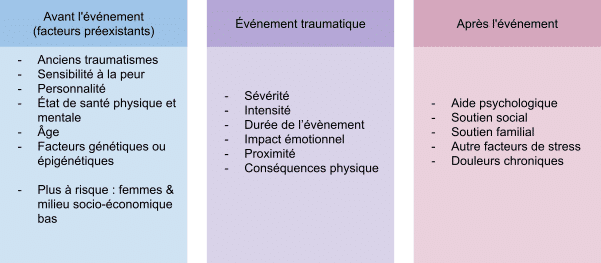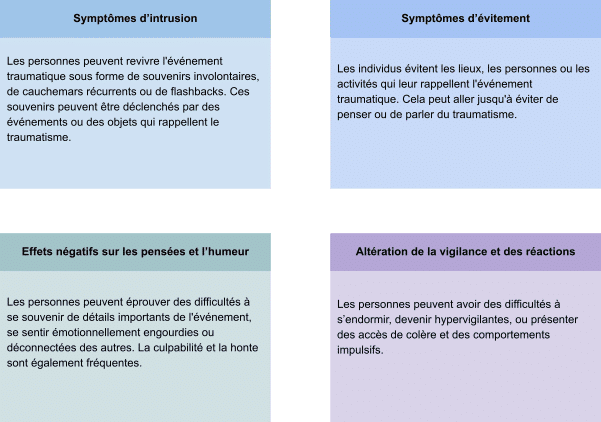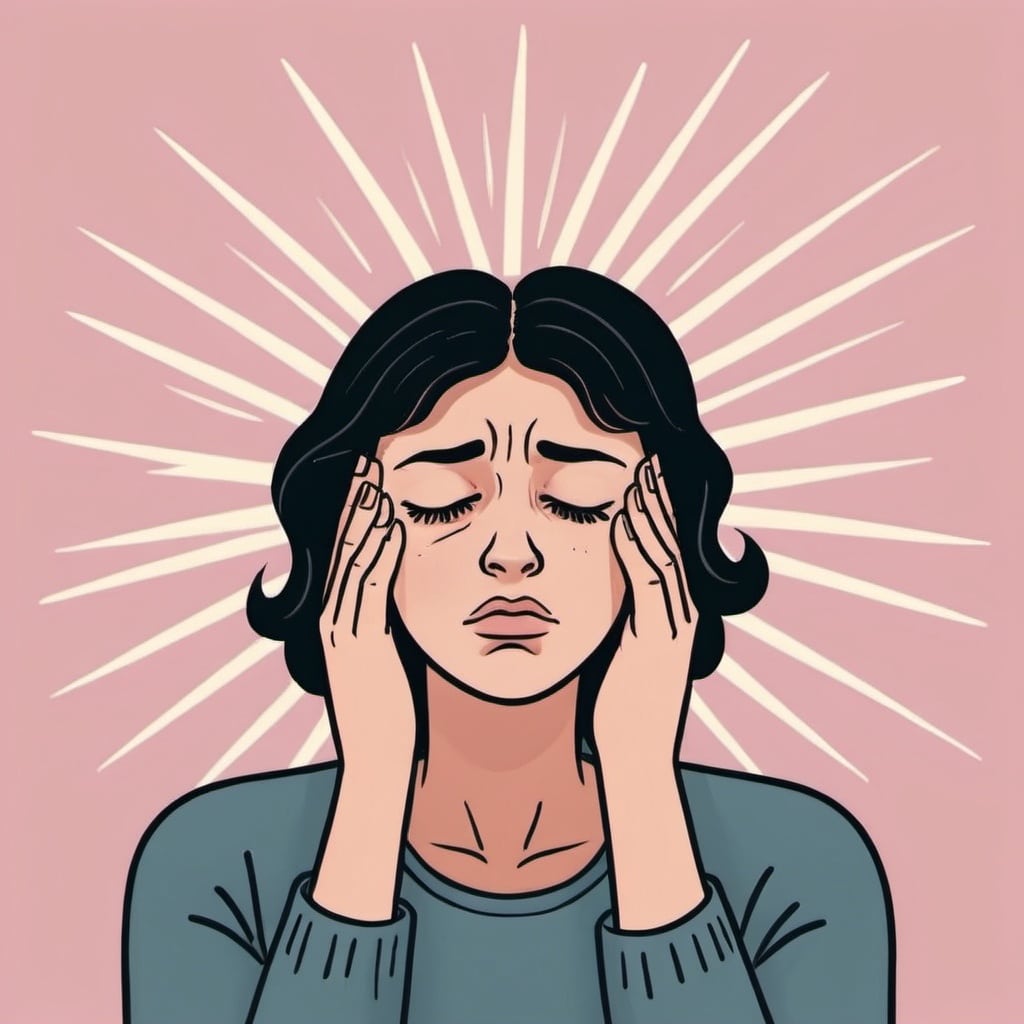Post-traumatic stress disorder (PTSD) is a complex disorder that can occur following a life-threatening event or serious injury. Affected individuals may suffer from intrusive memories, nightmares and a tendency to avoid anything that reminds them of the traumatic event. Although PTSD can be a debilitating problem, it’s important to know that effective treatments are available, including psychotherapy and medication.
| Contents: What is PTSD? Are we all at risk? What are the symptoms of PTSD? Diagnosing post-traumatic stress disorder Treatment Understanding the neurobiological mechanisms Conclusion |
What is PTSD?
PTSD can develop after terrifying events such as fighting, sexual assault, natural or man-made disasters. It can also result from experiences perceived as overwhelming, such as physical violence or a car accident. People may be exposed to these events directly or indirectly, for example, by witnessing the pain or death of others.
PTSD can occur when our ability to cope with intense stress is exceeded, as is often the case when faced with the threat of imminent death. In such situations, a state of shock may be observed. Sometimes, an acute stress reaction – an intense, dysfunctional response – occurs within a month of the event. If the body fails to stabilize after this time, PTSD is considered to have developed.
Are we all at risk of developing it?
Interestingly, some people can go through similar traumatic events without developing post-traumatic stress disorder (PTSD), while others may suffer from it after seemingly less severe experiences. Around 9% of the general population will experience symptoms of PTSD in their lifetime, and around 4% suffer from it every year.
PTSD is the result of a complex interaction between three main groups of factors.

Firstly, pre-existing factors such as past painful experiences, sensitivity to fear, personality, as well as a person’s state of physical and mental health, not to mention their age at the time of the triggering event. Genetic or epigenetic factors influencing brain plasticity also play a role. It is worth noting that women and people with a lower socio-economic or educational level are identified as being more at risk.
Secondly, the nature of the event itself is crucial: severity, intensity, duration, emotional impact, proximity and physical consequences are all elements that can modify the risk of developing PTSD.
Finally, the post-traumatic context is crucial. The existence of psychological, social and family support is invaluable, while additional stress factors, such as chronic pain, can increase the risk of PTSD. In short, even a person with no particular vulnerability can develop PTSD in certain circumstances.
What are the symptoms of post-traumatic stress disorder?
The symptoms of PTSD are generally classified into four categories:

Other symptoms: Some people with PTSD adopt specific behaviors to manage their anxiety, such as rituals (e.g., repeated bathing after sexual assault) or the use of alcohol and drugs, which can lead to substance-use disorders. A dissociative subtype of PTSD, characterized by symptoms such as depersonalization (feeling detached from oneself) and derealization (perceiving the world as unreal), is also recognized.
Diagnosis of PTSD is based on clinical assessment by health professionals. Diagnostic criteria include :
- Exposure to a traumatic event,
- Symptoms persist for at least one month.
- A significant impact on day-to-day operations.
- Symptoms are not due to other disorders or substances.
Treatment approach
Self-care
It is essential that people affected by trauma adopt self-care measures. This includes seeking personal safety, maintaining good physical health, and practicing mindfulness. Establishing a regular schedule and engaging in pleasurable activities can also help manage symptoms.
Psychotherapy
Psychotherapy is often the cornerstone of PTSD treatment. Trauma-focused cognitive-behavioural therapy is particularly effective. It involves educating patients about PTSD, helping them to modify their thoughts related to the traumatic event, and providing controlled exposure to their memories. Approaches such as eye movement desensitization and reprogramming (EMDR) are also used.
Medicines
Medication, particularly antidepressants, can be prescribed to help relieve the symptoms of PTSD. Selective serotonin reuptake inhibitors are commonly used, but other medications may also be considered depending on the individual’s specific symptoms.
A deeper understanding of neurobiological mechanisms
Numerous studies have advanced our understanding of the mechanisms involved in the development and chronicization of post-traumatic stress disorder (PTSD), although many aspects remain to be elucidated. In particular, the contribution of genetic and epigenetic mechanisms is a promising area for explaining individual vulnerability to traumatic events.
Genome-wide genetic association studies (GWAS) have shown links between resilience, measured using validated scales, and certain genetic variations. These variations concern genes regulating the hypothalamic-pituitary-adrenal axis and mediators of inflammation, underlining the importance of biological predispositions in the stress response.
Epigenetic changes influence the expression of genes involved in the transport of serotonin (“happiness hormone”) and neurotrophic factors (a family of proteins responsible for the growth and survival of developing neurons and the maintenance of mature neurons). In parallel, brain imaging data revealed hyperactivity in the amygdala, responsible for emotional feelings, and hypoactivity in the hippocampus, involved in declarative memory. The latter structure also shows a reduction in volume, a factor of vulnerability to PTSD.
Biologically, the mechanisms involved are characterized by disruption of the hypothalamic-pituitary-adrenal axis, with excessive release of stress mediators such as cortisol. In addition, various neuromediators, such as those of the dopaminergic (locomotion, motivation and cognition) and glutamatergic (our brain’s main neurotransmitter) systems, are affected. Periaqueductal gray matter, involved in defense and avoidance reactions, also shows increased activity.
Conclusion
Providing a safe space, establishing caring communication and adapting your gestures to respect everyone’s comfort are essential approaches to calming the anxiety of people suffering from post-traumatic stress disorder (PTSD). As a manual therapist, you can play an important role in helping to release the physical tensions often associated with their emotional state. While it’s not your role to diagnose, it’s crucial to remain alert to signs of distress, and to encourage your customers to consult qualified professionals if necessary. Every step, however small, towards better managing the effects of PTSD is a significant advance. Patience, empathy and support are essential to accompany these people on their path to recovery and serenity.
To remember:
- PTSD occurs after major trauma and affects around 9% of the population over the course of their lives, influenced by individual factors, the severity of the trauma and post-event support.
- Symptoms: Intrusion (memories, flashbacks), avoidance, cognitive changes (guilt, depression), and hypervigilance (sleep disorders, irritability).
- Research into PTSD highlights the importance of genetic, epigenetic and neurobiological mechanisms, involving alterations in the stress axis, brain mediators and structures such as the amygdala and hippocampus, in the vulnerability and chronicization of the disorder.
- Treatments: Psychotherapy (CBT, EMDR), medication (antidepressants) and self-care (mindfulness, routine).
Sources :
- American Psychiatric Association (2022). Diagnostic and Statistical Manual of Mental Disorders: DSM-5-TR.
- Barnhill, J. W. (2023). Post-traumatic stress disorder (PTSD). MSD Manuals for the General Public. https://www.msdmanuals.com/fr/accueil/troubles-mentaux/anxi%C3%A9t%C3%A9-et-troubles-li%C3%A9s-au-stress/trouble-de-stress-post-traumatique-tspt
- Barnhill, J. W. (2023). Acute stress disorder. Manuels MSD Pour Le Grand Public. https://www.msdmanuals.com/fr/accueil/troubles-mentaux/anxi%C3%A9t%C3%A9-et-troubles-li%C3%A9s-au-stress/%C3%A9tat-de-stress-aigu
- Post-traumatic stress disorders – Inserm, La science pour la santé. (2020). Inserm. https://www.inserm.fr/dossier/troubles-stress-post-traumatique/

